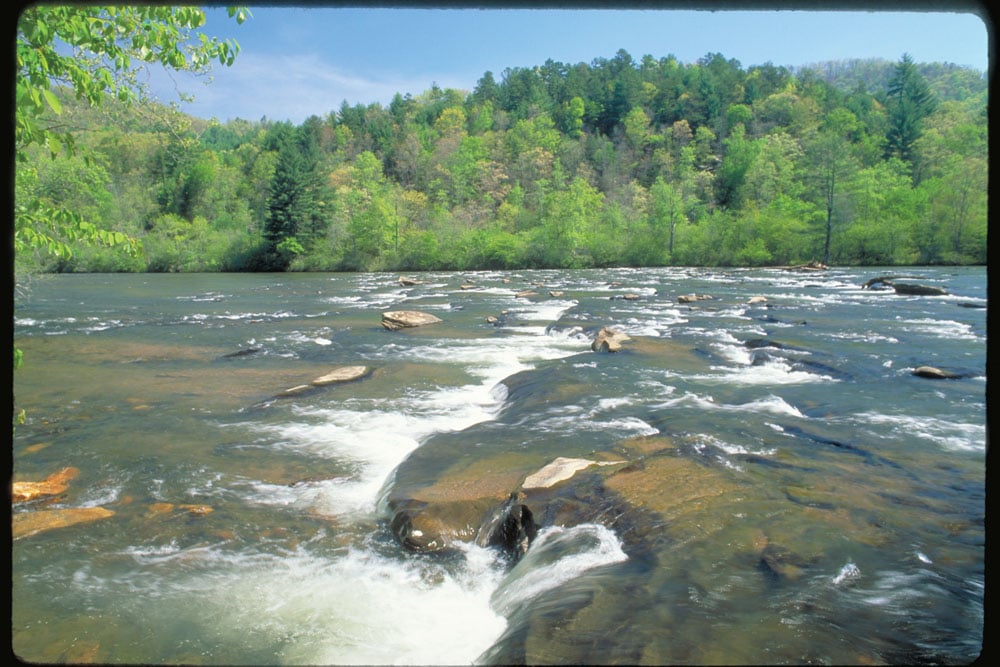YES, THE MANAGEMENT PLAN COULD HAVE BEEN WORSE. BUT THAT DOESN’T MAKE IT GOOD.
At first blush, you could call it a victory. Recently the U.S. Forest Service released a long-term management plan banning oil and gas drilling on all but 177,000 acres of the George Washington National Forest. That portion is currently under gas lease or subject to private mineral rights, and it represents a fraction of the GW’s 1.1 million acres, the vast majority of which will remain closed to drilling. A cause for celebration? Perhaps.
“This decision protects the existing uses and values of the special George Washington National Forest,” said Sarah Francisco, senior attorney at the Southern Environmental Law Center. “As a native Virginian who grew up in the Shenandoah Valley, I’m pleased that the U.S. Forest Service has done the right thing and recognized that the [GW]—a beloved place for our entire region—deserves protection.”
In one sense, Francisco is right; drilling in part of the largest national forest in the East—enjoyed by more than one million people annually—is better than turning the whole thing into an industrial zone for resource extraction. But it’s painfully obvious that the Forest Service caved in to the oil and gas industry just enough to have its cake and eat it too. By threading this particular needle the way it did, the government fended off costly industry lawsuits that would have been filed in the wake of a total drilling ban, left the door open for drilling in other national forests, and mollified some of those pesky environmentalists who care about trivialities like clean water. Quite the hat trick. Robert Bonnie, the U.S. Department of Agriculture’s undersecretary for natural resources and environment, seemed quite pleased with himself in preserving the status quo. “We think we’ve ended up in a much better place, which is we are allowing oil and gas drilling,” he told The Associated Press concerning the final GW management plan. “From a policy perspective, the Forest Service allows fracking on forest lands throughout the country. We didn’t want to make a policy decision or change policy related to fracking.”
The Forest Service didn’t want to make a policy decision? Isn’t that its job? Not to mention that issuing drilling permits for nearly a fifth of the GW is a policy decision—one that ignores what fracking will do to vital wildlife habitat, priceless outdoor recreational opportunities, and drinking water (directly or indirectly) for some 4.5 million people. It also leaves the option of drilling in other national forests in the region like the Cherokee and Pisgah-Nantahala, where management plans are now being revised. (The Pisgah-Nantahala plan already contemplates expanding logging into 70-90 percent of that national forest’s acreage.)
Some environmentalists have spoken out against opening the Pandora’s box of fracking, even a little bit. ”Unfortunately, allowing the use of fracking within a part of the George Washington National Forest is part of the Obama Administration’s embrace of oil and gas drilling, despite the water, air and climate pollution that is proven to come along with it,” said Earthworks energy program director Bruce Baizel. “In the face of dire warnings from the world’s foremost climate scientists about the need to phase out fossil fuels by 2100 and an authoritative body of science demonstrating the health impacts faced by communities living near oil and gas development, this administration continues to promote an ‘all of the above’ energy policy rather than a swift transition to renewable energy.”
Baizel also pointed out that nearby communities, local governments, Virginia governor Terry McAuliffe, and every major water utility in the Washington D.C. area opposed drilling in the GW. As a matter of fact, so did the Forest Service itself at one point. Its draft management plan released three years ago would have banned all horizontal drilling, including fracking. But naturally Big Oil was having none of that, so the agency, duly cowed, reversed itself. And everyone who’s not an industry executive in a $3000 suit is worse off as a result. Pumping huge quantities of chemical-laden water into the ground to break up shale formations threatens critical groundwater supplies and produces piles of hazardous waste, much of which is temporarily stored in open-air pits. According to Appalachian Voices, an environmental group, both wells and waste-containment ponds can release toxic chemicals into the air and water. In Pennsylvania, for example, state officials have confirmed 243 known cases of private drinking water well contamination by the natural gas industry since drilling expanded there in 2008.
Beyond all this, drilling in the GW further entrenches our short-sighted reliance on fossil fuels. President Obama’s “all of the above” energy policy, which Bonnie cited in justifying drilling in the GW and seems to think the world of, is really a cop-out; it props up Big Oil at the expense of the environment while pretending to be green. (Pay no attention to those giant holes in the earth spewing black sludge! Check out these shiny solar panels!) The smarter play would be to follow New York’s example, which recently banned fracking state-wide. Governor Andrew Cuomo apparently understands something that our national leaders do not: the longer we allow ourselves to depend on oil and gas, the longer it will take to move to the sustainable-energy economy that most politicians say they want—unless it costs them votes or campaign contributions. Cuomo stood up to Big Oil, and we should hold all of our elected representatives to the same standard. •








